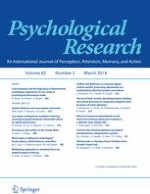24-10-2016 | Original Article
Spatial attention across perception and action
Gepubliceerd in: Psychological Research | Uitgave 2/2018
Log in om toegang te krijgenAbstract
We hypothesize that a shared spatial attention mechanism is used for both perception and action. To this end we created a new dual-task version of the classical Simon task. In one task, the spatial-input task, associated with input spatial attention, participants named one shape out of two bilaterally presented colored shapes. In a second task, the spatial-output task, associated with output spatial attention, participants discriminated between high and low pitch tones by pressing either a left or a right key. In Experiment 1, input for both tasks appeared simultaneously, and participants were instructed not to prioritize either task. A between tasks Simon-like effect was found for responses to both tasks. Reaction times were shorter when the side of the relevant shape in the spatial-input task and the side of the correct response in the spatial-output task were congruent. In Experiment 2, we manipulated the stimulus-onset asynchrony (SOA) between the inputs for the two tasks and showed that the Simon-like effect remained intact at all SOAs. Experiment 3 was similar to Experiment 1 except that the vocal response for the spatial-input task was not speeded. A Simon-like effect was still observed. Experiment 4 was the same as Experiment 3 except that the non-speeded response for the spatial-input task was manual rather than vocal. No Simon-like effect was observed in this experiment. Our results support a shared spatial attention mechanism involved in the Simon effect and indicate that this spatial attention mechanism is shared by perception and action.
